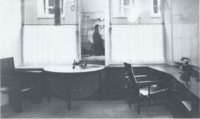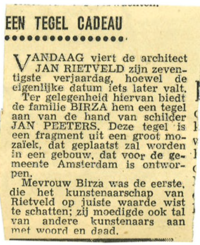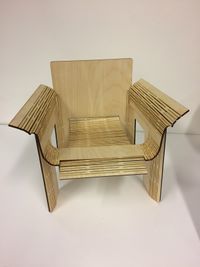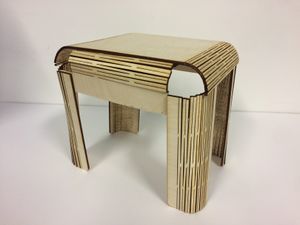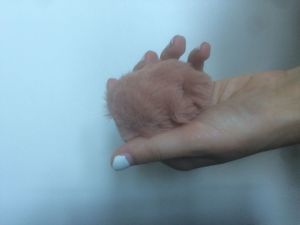User:0927758
Contact
Charlotte Birza
0927758@hr.nl
Fine Art & Design Teacher Training
Year 2
For my Reflection Document see Osiris or on this link: https://drive.google.com/file/d/18hBzjhVM5DG7yr3JqBK9FnBKDfIHvwLq/view?usp=sharing
Digital Craft: The Birza-chair by Gerrit Rietveld
Gerrit Rietveld and the Birza-family
For this practice, Digital Craft, I chose to work with the Birza-chair by Gerrit Rietveld. I first heard about Rietveld when my father told me that this famous architect designed and built a room for my great-grandparents in their house in Amsterdam.
At the time Rietveld was not yet a famous architect. My great-grandparents enjoyed buying work by young artists. Their son, my grandfather, inherited the Birza-room from his parents. The pieces of furniture included the Birza-chair. This chair was designed in 1927. Rietveld tried to design a chair, made out of one piece of material, that could easily be factory-produced. It is made of fiber. The production-process was so complicated and cost so much time, that only one was built.
The room doesn’t exist anymore. After my great-grandparents moved most of the interior of the Birza-room stood in the house of my grandparents. My father told me it was not suitable for daily use because the furniture was very vulnerable.
In 1986 my grandparents offered the furniture in their possession to the Gemeentemuseum in The Hague. The Gemeentemuseum appeared only moderately interested. On hearing that the furniture would not be put on display and would be kept in storage, my grandparents decided to put it up for auction at Christie’s in Amsterdam. This auction created much publicity, as it was the largest collection of Rietveld-furniture ever to be auctioned.
This story about Rietveld and the Birza-family was so interesting that it triggered me to research Rietveld and the part my great-grandparents played in the discovery of this architect. I started my research in our cellar at home. In a box I found various interesting pieces of Rietveld-material. I found correspondence from Rietveld to my great-grandparents, a design for a double grave for my great-grandparents, samples of waterproof wallpaper (very unusual for 1930), a garden-design and a few designs for furniture.
- Letters from Rietveld
I found correspondence between 1927 and 1958. One can read about the friendly relationship between my great-grandparents and Rietveld. He frequently writes about visiting them. In a letter dated November 15, 1929 Rietveld writes, that ‘The Chair’ has undergone many changes. He has started working on it again. He writes: ‘I hope you are not offended that I started experimenting again on your chair. It has been drastically pruned. I shall finish it shortly and send it to you (it is taking too long).
On September 6, 1950 Rietveld writes about the Birza-room: ‘It was one of the coolest interiors I made and when revisiting it I was always surprised by the suggestion of space it gave. I must say you also supported the colouring well with your choice of paintings and drawings. My congratulations on your becoming grandparents. If you ever want to get rid of the fiber chair I would like to make a first offer. R.’ The grandchild he mentions is my father.
On April 18, 1954 Rietveld writes: ‘…. My work for you was of little consequence. Payment is absolutely not necessary; you were one of the few, who in times, when our work was still strange to people, had trust. That has been more than enough payment.’
Who was Gerrit Rietveld?
Gerrit Thomas Rietveld was born on June 24 of 1888. Like his father he was a cabinet maker. Later he became an architect. Al his life he lived in Utrecht. He became famous for The Rietveld –Schröder house and his chairs. Until his death on June 25, 1964 he worked as an architect and designer. He was always in search of new possibilities. It is often thought that Rietveld thought of the red-blue chair and the Rietveld-Schröder house overnight. This is certainly not true. His designs were often the result of much experimentation.
It was important to Rietveld that many people could buy his designs. Therefor he used cheap materials. He tried to find ways in which his furniture could be factory-produced. He experimented with methods too. He wanted to design furniture and houses, that could be produced industrially. Only a few of his houses were ever built. In the twenties and thirties Rietveld was appreciated, as a person, as an architect and as a designer of furniture. The simplicity of his work was seen as liberating. Rietveld was always experimenting with materials. It not always occurred to him, that his designs should also be practical in use. The criticism that was the result did not interest him. He saw the criticism as proof of being on the right track. In the periodical ‘De Stijl’ nr. 46 (1927) he wrote. ‘Every true creation…. changes the insight, the demands and the needs of its time and clashes with the prevailing demands and needs of previous periods. A creation must therefore gain the position instead of falling in with the prevailing demands and the necessity’.
Design characteristics
In his designs Rietveld used straight lines and planes. He didn’t use no ornamentation. Everything was simple. He wanted to show how things are made.
His designs were not always practical. Comfortable use was less important. ‘De Stijl’ and ‘Het Nieuwe Bouwen’ helped Rietveld reduce everything to the simplest elements. In making his furniture Rietveld was in search of different techniques to make connections.
Conclusion
Rietveld is known for his house and his chair. The availability of his furniture and his houses was important to him. Whether they were practical in use was of less interest. He once said when someone complained about the hardness of his chairs: ‘If you are tired you must go to bed’.
With his designs, which were very different from what people were used to at the time, he has made people look differently at furniture and houses.
I think my great-grandparents only contributed a little bit to Rietveld becoming well known. Their commission is only one in a long list of Rietveld’s work. The auctioning of the Birza-room on the other hand caused a lot of publicity because it was exceptional for so many pieces of furniture designed by Rietveld to be sold on a single occasion. I suppose the Gemeentemuseum regrets its decision not to accept the offer of my grandparents because of the condition to put the furniture on display.
Copy and transformation
It was very enjoyable to look though the material of Rietveld we have in our possession. Reading the correspondence was a special experience.
I investigated the Birza-room with special attention to the Birza-chair. This chair is made of one piece of fibre-material. I asked myself how I would be able to make a chair like that. Is it easier with modern techniques? Is it possible with the use of a laser cutter? The copy I made of the chair is also made from one piece of material. I took the design of the chair from the site of the Stedelijk Museum in Amsterdam and started thinking of a way to fabricate this chair with the use of a laser cutter. During this process I discovered I did not know how big the flexible parts in the chair should be to be able to bend the plywood. When I made the first model I made the flexible parts to small. As a result the plywood could not be bent far enough.
For the next model I made the flexible parts bigger. This model could be bent far enough but it was still difficult to put it all together. I am sure Gerrit Rietveld also encountered this problem.
I also found that the blueprint I used did not correspond completely with the chair we now know. The seat is to deep causing it to stick out.
- Copy Birza-chair
Finally I wanted to make a flexible design following Rietveld’s idea for the Birza-chair. To transform the chair I decided to make a stool. The most difficult part turns out to be making a design with big flexible parts and still make it strong enough to stand firm. The flexible parts make the material fragile. I understand Rietveld’s idea about experimenting with furniture made out of one piece of material. I immediately understood the difficulty in making a stool and easy to assemble design. I now see why only one Birza-chair was made. After having built the Birza-chair cabinet maker V.d. Groenekan is supposed to have said: ‘Never again! I gave it a go but I think Ikea is better.
- Transformation Stool
Year 3
Project 1: Critical Making exercise
Flupsel
— Project from Daphne, Marije, Charlotte & Charlotte —
The first assignment, a critical making excercise.
Our provided set of cards were:
- Advanced information visualisation (Infoviz)
- Use fabric to design this object as a wearable or soft thing
- Highlight a distopic future that could result from…
Our first idea was to make a ‘’stress sweater’’, something that would show the outside world how ‘’safe’’ it would be to approach you in that moment. Also it related to the way we as a society wish to hide such emotions.
However, when we were further discussing the distopic future aspect of it, the sweater idea did not hold up to the story element we prefer to work with.
Then our focus swifted to things like the 90’s ‘’moodring’’ and other exciting products which portray information on your body. Like the smart sports t-shirt that tracks your heartbeat and sweat. Also technologies like Alexa and the movie ‘’Her’’ gave us insight in what direction we wanted to go.
One of our big influences was the distopic Netflix show Black Mirror. In season 3, the episode ‘’Nosedive’’, a point system was used to show an individual ‘’socioeconomical status’’. (for more info see the Wiki + trailer)
In a distopic future, such as in the society we live in now, certain products, services and even rights are depended on your social status.
We wanted to use the fabric as a tool and chain to the individual comparable to our smartphone now.
The Flupsel’s main goal is to eradicate human’s most basic flaw and instinct. The ability to lie and bend the truth. In a world where fake news is consumed daily, the idea is to purify the complicated web of information that flows around us. However, such as many systems in the past, over time it becomes corrupted by greed. An individual receives his/her Flupsel by birth. And over time becomes conditioned into always striving for the ultimate truth. (We were inspired by brave new world’s conditioning)
To try and simply show our idea, we have composed a scene that gives the viewer an idea of how the Flupsel can affect many aspects of your life. The Scene: A job interview at a lawyer’s firm. Click here to see the video.
Reflection
The idea that people should always take a Flupsel with them and that the Flupsel will save all your data and keep this information forever is a horrible idea. The Flupsel will score everything about you and with this information invites you to always speak the truth. With the Flupsel you will live your life trying to please everyone. You will portray and project the image of yourself to others. Points given to you by the Flupsel define your value. Everyone would be terrified of getting a low score because the consequences could be very unpleasant.
We cooperated very well during this project. We had thorough discussions and agreed on the idea. The idea comes form the Critical Making Cards. We figured out something the world is basically already doing. The world is becoming more digital. All our information is on the internet: Big brother is watching you.
Because we attend different courses, making appointments was difficult. In addition there was little time. In the little time we had I think the creation of the Flupsel went well. If I would continue this assignment I would find it really fantastic to make the Flupsel work. The idea makes me curious though the technology is tricky. I wouldn’t know how I would have to deal with it. Actually I will need someone who is at home in engineering and robotics. I think at this time it’s no option to make this project really work.

